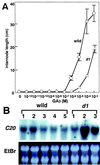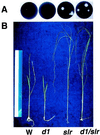Rice dwarf mutant d1, which is defective in the alpha subunit of the heterotrimeric G protein, affects gibberellin signal transduction
- PMID: 11027362
- PMCID: PMC17253
- DOI: 10.1073/pnas.97.21.11638
Rice dwarf mutant d1, which is defective in the alpha subunit of the heterotrimeric G protein, affects gibberellin signal transduction
Abstract
Previously, we reported that the rice dwarf mutant, d1, is defective in the alpha subunit of the heterotrimeric G protein (Galpha). In the present study, gibberellin (GA) signaling in d1 and the role of the Galpha protein in the GA-signaling pathway were investigated. Compared with the wild type, GA induction of alpha-amylase activity in aleurone cells of d1 was greatly reduced. Relative to the wild type, the GA(3)-treated aleurone layer of d1 had lower expression of Ramy1A, which encodes alpha-amylase, and OsGAMYB, which encodes a GA-inducible transcriptional factor, and no increase in expression of Ca(2 +)-ATPase. However, in the presence of high GA concentrations, alpha-amylase induction occurred even in d1. The GA sensitivity of second leaf sheath elongation in d1 was similar to that of the wild type in terms of dose responsiveness, but the response of internode elongation to GA was much lower in d1. Furthermore, Os20ox expression was up-regulated, and the GA content was elevated in the stunted internodes of d1. All these results suggest that d1 affects a part of the GA-signaling pathway, namely the induction of alpha-amylase in the aleurone layer and internode elongation. In addition, a double mutant between d1 and another GA-signaling mutant, slr, revealed that SLR is epistatic to the D1, supporting that the Galpha protein is involved in GA signaling. However, the data also provide evidence for the presence of an alternative GA-signaling pathway that does not involve the Galpha protein. It is proposed that GA signaling via the Galpha protein may be more sensitive than that of the alternative pathway, as indicated by the low GA responsiveness of this Galpha-independent pathway.
Figures






References
Publication types
MeSH terms
Substances
LinkOut - more resources
Full Text Sources
Other Literature Sources
Molecular Biology Databases
Miscellaneous

